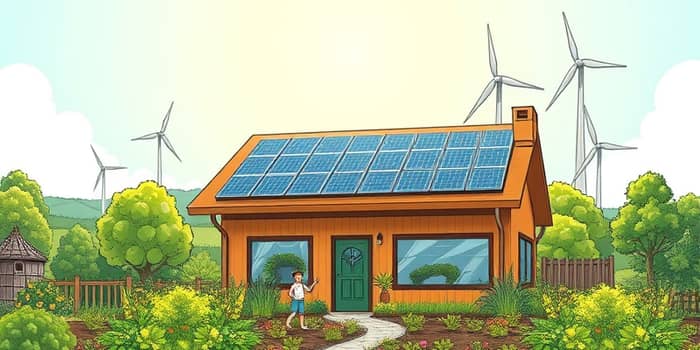Embracing a green lifestyle is more than just a commitment to the planet; it’s a pathway to robust financial health. By making mindful choices—from simple daily habits to significant home upgrades—individuals and families can uncover immediate and significant utility bill savings while contributing to a sustainable future. This article explores practical strategies and compelling data that demonstrate how eco-friendly living can lead to both short-term relief and substantial long-term financial benefits realized. Whether you’re a homeowner, renter, or business owner, the evidence is clear: going green pays off in countless ways.
Immediate Savings in Daily Life
One of the most rewarding aspects of a green lifestyle is witnessing tangible savings almost instantly. Small adjustments in daily routines can lead to surprisingly large reductions in expenses, empowering households to redirect funds toward other priorities.
For example, many Americans overlook the cost of so-called “vampire appliances”—devices that draw power even when turned off. Simply unplugging chargers, electronics, and kitchen gadgets when they’re not in use can shave about $20 off your monthly utility bill.
- Unplug unused electronics and chargers: approximately $20 saved per month.
- Switch to LED light bulbs: up to $75 saved per year per bulb.
- Use power strips with on/off switches: prevent standby power losses.
Over the course of a year, these steps accumulate, allowing families to see stable energy costs and greater financial security. Incorporating these habits into your daily routine is both simple and impactful.
Energy Efficiency at Home
The home is a powerhouse for energy consumption, and optimizing its performance can unlock significant reduction in energy costs while enhancing comfort. Simple retrofits and strategic upgrades yield high returns on investment over time.
Consider the following improvements:
*Average based on U.S. national data. **Annualized estimates.
For homeowners, installing solar panels can be transformative. Through net metering programs, surplus energy fed back to the grid translates into bill credits, sometimes eliminating electricity costs altogether. Initial expenses are often offset by federal tax credits and state incentives, accelerating the break-even point to just a few years.
These upgrades not only reduce ongoing expenses but also increase the overall value and desirability of your property in today’s environmentally conscious market.
Long-Term Investments and Increased Property Value
Beyond immediate savings, green upgrades represent smart investments that appreciate over time. Properties with energy-efficient features and sustainable certifications typically command higher resale prices and sell faster.
Studies indicate that homes with solar installations can see a value increase of up to 4.1% relative to similar residences without panels. Similarly, Leadership in Energy and Environmental Design (LEED) certified homes often fetch a 5 to 10% premium on the real estate market.
Additional benefits include reduced maintenance costs. Materials like metal roofing and composite decking, although more expensive upfront, outlast traditional alternatives and lower the need for costly repairs. Implementing rainwater harvesting systems reduces water bills and protects against drought surcharges.
Investing in sustainable landscaping—native plants, drip irrigation, and permeable paving—can dramatically cut outdoor water use by up to 50%. These measures enhance curb appeal and demonstrate sustainable and cost-effective choice to prospective buyers.
Eco-Friendly Transportation and Its Impact on Your Wallet
Transportation is often a major household expense. A shift toward greener commuting options can yield considerable savings over time, reduce dependence on volatile fuel prices, and minimize vehicle maintenance costs.
- Public transportation passes: can cost 30–60% less per month than fuel and parking fees for a personal vehicle.
- Biking or walking for short trips: zero fuel costs and minimal maintenance expenses.
- Electric vehicles (EVs): federal tax credit up to $7,500, plus savings on fuel and reduced servicing needs.
For many families, transitioning to an EV or plug-in hybrid can save upwards of $1,000 annually on gasoline alone. When combined with home-based charging powered by solar panels, the long-term financial gains become even more compelling.
Sustainable Consumption: Everyday Habits that Save Money
Adopting sustainable consumption patterns extends beyond energy and transportation. The ways we shop, eat, and manage waste have significant financial implications.
- Bulk purchasing: reduces packaging waste and often lowers unit costs by up to 20%.
- Reusable items: investing once in quality products—water bottles, cloth bags, rechargeable batteries—eliminates recurring costs.
- Meal planning and composting: prevents food waste, saving approximately $1,500 per year on groceries while producing nutrient-rich soil for gardens.
By focusing on resource efficiency, households can unlock lifelong savings ten times greater than the initial investment in sustainable products and systems.
Practical Steps to Start Your Green Journey Today
Embarking on a green lifestyle is an empowering process. Begin by conducting an energy audit or reviewing utility bills to identify high-cost areas. Explore local rebates, tax credits, and low-interest financing options for eligible upgrades. Set measurable goals—such as reducing monthly energy use by 10%—and track progress using simple apps or spreadsheets.
Form habits gradually: commit to one new sustainable practice each month, whether it’s switching to LED lighting, investing in a reusable water bottle, or taking public transportation twice a week. Celebrate each milestone and reinvest the saved money into further eco-friendly initiatives.
The cumulative effect of these actions produces a ripple of financial and environmental benefits. By aligning your spending with your values, you create a legacy of stewardship—improving your own financial security while contributing to a healthier planet for future generations.
Conclusion: A Greener, Wealthier Future
Adopting a green lifestyle is not about sacrificing comfort or convenience; it’s about enhancing both environmental and financial well-being. From immediate utility bill savings to enduring property value increases, the data and real-life experiences show that going green is a pathway to prosperity.
By integrating sustainable practices into everyday life, individuals and families unlock a powerful synergy between ecological responsibility and fiscal prudence. The journey toward a greener future begins with a single step—one that promises dividends far beyond the balance sheet.
References
- https://www.arbor.eco/blog/sustainability-statistics
- https://resimpli.com/blog/green-building-statistics/
- https://greenerideal.com/guides/the-financial-benefits-of-mindful-and-sustainable-choices/
- https://www.firstalliancecu.com/blog/money-saving-benefits-of-going-green
- https://paylesspower.com/blog/going-green-how-americans-are-making-their-homes-eco-friendly/
- https://icma.org/documents/costs-and-financial-benefits-green-buildings










